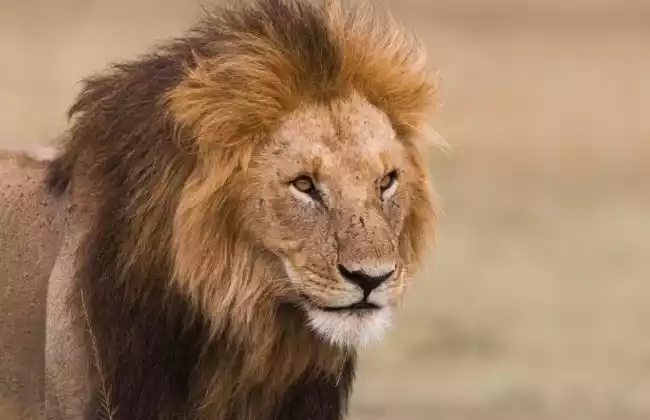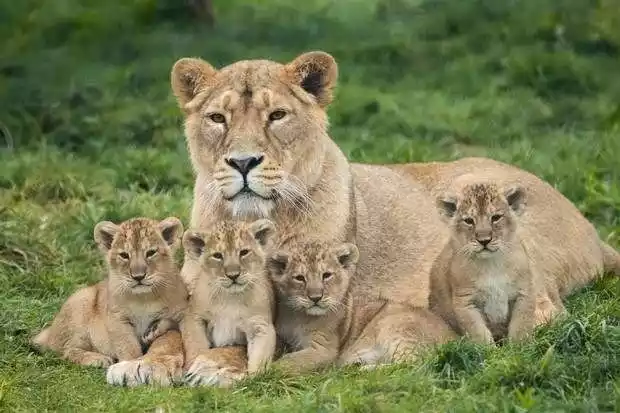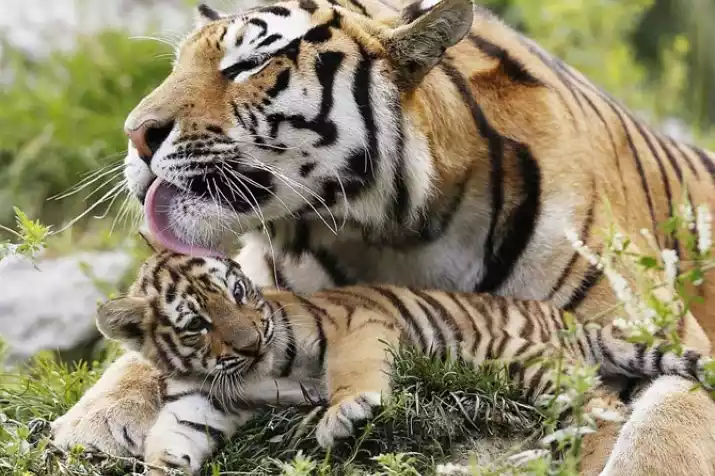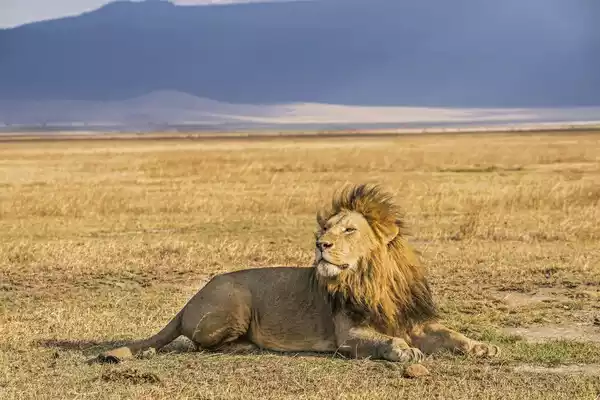The enduring debate between Lion and Tiger two magnificent big cats, is an intriguing topic in the animal world. Both exemplify beauty, strength, and grace, however, they have striking differences.
The lion, with its breathtaking hair and communal pride, is a symbol of unity and collaboration. The social cats rule the savannas in Africa with their coordinated hunts and distinctive roars that echo throughout their territory.
However, the tiger, which is solitary and quiet, wanders through the forests of Asia with a stunning grace. The dazzling striped coat hides it in the lush vegetation and is a powerful symbol of solitary strength and independence.
Lions (Panthera leo)
Lions (Panthera leo) are large carnivorous mammals belonging to the Felidae family. They are iconic for their majestic appearance, characterized by a tawny coat, a prominent mane in males, a muscular build, and a regal bearing. Lions are highly social animals, often found in groups known as prides, comprising related females, their offspring, and a few resident males.

These apex predators primarily inhabit savannas, grasslands, and open woodlands across sub-Saharan Africa, where they hunt cooperatively, preying mostly on large ungulates such as zebras, wildebeests, and buffalo. Lions are renowned for their distinct roars, which serve as a means of communication within the pride and to assert territory.
Historically, lions have held cultural significance, being revered as symbols of strength, courage, and royalty in various cultures, prominently in heraldry, literature, and folklore. However, due to habitat loss, poaching, and human-wildlife conflicts, their populations have faced significant decline, leading to conservation efforts to protect these magnificent creatures.
Tigers (Panthera tigris)
Tigers (Panthera tigris) are the largest of all big cats and are instantly recognizable by their striking orange-reddish fur coat adorned with black stripes, which serve as excellent camouflage in their forest habitats. They belong to the Felidae family and are solitary hunters, roaming across diverse landscapes such as forests, grasslands, and mangrove swamps in various parts of Asia.
These apex predators are known for their muscular build, powerful jaws, and acute senses. Tigers primarily hunt large ungulates like deer and wild pigs, utilizing stealth and strength in solitary ambushes to bring down their prey.
Tigers have a notable significance in various cultures, symbolizing power, prowess, and mystique. Unfortunately, they are listed as endangered due to habitat loss, poaching for their valuable parts used in traditional medicine, and conflicts with humans.

Conservation efforts are underway to protect tiger populations and their habitats, focusing on preserving their dwindling numbers and ensuring their survival in the wild.
Comparison chart
Here’s a comparison chart of differences between lions and tigers:
| Characteristics | Lion | Tiger |
|---|---|---|
| Physical Appearance | Tawny coat, some males have manes | Orange-reddish coat with black stripes |
| Size | Smaller than tigers | Largest among big cats |
| Habitat | Savannas, grasslands | Forests, grasslands, swamps |
| Social Structure | Live in prides (females and offspring with a few males) | Solitary creatures |
| Communication | Roaring as a means of communication | Vocalizations and body language |
| Hunting Behavior | Cooperative hunting in groups | Solitary ambush predators |
| Prey | Hunt large ungulates (zebras, wildebeests) | Hunt large ungulates (deer, wild pigs) |
| Conservation Status | Vulnerable/Threatened | Endangered |
| Geographic Distribution | Sub-Saharan Africa | Various parts of Asia |
| Symbolism & Culture | Symbol of royalty, courage | Symbol of power, mystique |
Physical Characteristics of Lion and Tiger
Lions
Lions, with their distinctive tawny-colored fur, exhibit sexual dimorphism where males often have a prominent and impressive mane encircling their heads, necks, and shoulders.
The mane varies in color and density among individuals, with some lions displaying fuller and darker manes, indicating maturity and dominance. In contrast, lionesses lack the mane and possess a sleeker appearance, though they share the same tawny coat with the males.
Adult male lions typically weigh between 330 to 550 pounds (150 to 250 kilograms) and can reach lengths of around 8 to 10 feet (2.4 to 3 meters) from nose to tail tip. Lionesses are generally smaller and lighter, weighing between 265 to 400 pounds (120 to 180 kilograms).
Tigers
Tigers, characterized by their striking orange-reddish fur adorned with dark black stripes, possess a robust and muscular build. Unlike lions, both male and female tigers display a distinctive striped pattern across their bodies, which helps them camouflage effectively in their natural habitats.
Tigers are the largest of all big cats, with adult males reaching weights between 400 to 700 pounds (180 to 320 kilograms) and lengths of approximately 8 to 10 feet (2.4 to 3 meters) from nose to tail.
Female tigers are slightly smaller, weighing around 220 to 370 pounds (100 to 170 kilograms). Each tiger’s stripe pattern is unique, similar to human fingerprints, and serves as a visual identifier among individuals within the species.
Lion vs Tiger: Life span
The average lifespan of lions and tigers can vary in the wild and in captivity:
Lions typically live for around 10 to 14 years in the wild. However, in captivity, where they are protected from various threats and provided with proper care, they can live longer, often reaching an age of 20 years or more.
Tigers, in the wild, generally have a lifespan of about 10 to 15 years. Similarly, in captivity, where they receive adequate nutrition, veterinary care, and a controlled environment, they can live longer than their wild counterparts. Some tigers in captivity have been known to live into their late teens and occasionally into their early twenties.
It’s important to note that these lifespans can be influenced by various factors such as habitat conditions, availability of food, natural threats, genetic diversity, and the overall health of the individual animals. In protected environments like well-managed zoos or sanctuaries, where they receive proper care, their lifespans can be extended beyond what they might experience in the wild.
Reproduction and Life Cycle of Lions
The reproduction and life cycle of lions involve various stages and social dynamics within prides:
Lions are polygynous, which means that dominant males within a pride mate with multiple females. Breeding can occur throughout the year, but there may be peaks associated with environmental factors like the availability of food. After a gestation period of about 110 days, lionesses give birth to a litter typically consisting of 1 to 4 cubs. The cubs are born blind and rely on their mother for nourishment and protection during their early weeks.

The pride plays a crucial role in raising the young. Lionesses within the pride often synchronize their breeding cycles to help rear the cubs collectively, nursing each other’s offspring and providing protection. The cubs start to explore their surroundings at around three months of age and are gradually weaned off their mother’s milk as they learn to eat meat. Lions reach sexual maturity at around 2 to 3 years of age.
Male lion cubs are eventually forced out of the pride by dominant males as they mature, seeking their territories and pride to rule. This process prevents inbreeding within the group. Lionesses may stay within their birth pride or, in some cases, form new pride with other unrelated lionesses.
The life cycle of lions is marked by the passing on of roles within the pride, with older generations providing guidance and protection until the younger ones take over the responsibilities of hunting and maintaining the pride’s territories.
Reproduction and Life Cycle of Tiger
Female tigers reach sexual maturity between 3 to 4 years of age, while males mature around 4 to 5 years. Tigers typically breed throughout the year, although mating frequency may increase during certain seasons.
After a gestation period of approximately 3 to 3.5 months (about 90 to 110 days), a female tiger gives birth to a litter of usually 2 to 4 cubs, although larger litters are possible. Newborn tiger cubs are blind and are dependent on their mother for the first few weeks.
The mother tiger provides care, protection, and nourishment to her cubs, teaching them hunting skills as they grow. Cubs start to learn to hunt around 6 months of age but remain with their mother for about 18 to 24 months before venturing out independently.

As they mature, young tigers gradually leave their mother’s care to establish their territories and seek their own independence. They reach sexual maturity between 3 to 4 years for females and 4 to 5 years for males, at which point they can begin breeding and continuing the life cycle of tigers.
Lion vs Tiger: Fights who would win?
In a confrontation between a lion and a tiger, the outcome is unpredictable and could vary based on various factors such as size, age, fighting experience, and individual temperament. Both are apex predators with different strengths. Tigers are generally larger and have more powerful forelimbs, while lions have stronger hind legs and a robust mane for protection.
Historically, hypothetical fights between lions and tigers have occurred in captivity, with no definitive winner. Sometimes the larger size and more solitary nature of tigers have been considered advantageous, while the teamwork and social structure of lions could potentially be an advantage.
Ultimately, these confrontations are rare and typically do not occur in the wild, as lions and tigers inhabit different continents. Their behaviors and ecosystems are distinct, reducing the likelihood of direct encounters.
Habitat and Distribution

The majority of lions live in savannas, open woodlands, and grasslands in sub-Saharan Africa. They can be found in various countries, including Tanzania, Kenya, South Africa, Botswana, and other countries. Their habitat covers a wide range of habitats where predator species are plentiful, allowing them to flourish in a variety of environments.
Tigers are mostly located in grasslands, forests, and mangrove swamps in Asia. They live in countries like India, Russia, Indonesia, Malaysia, and others. They are adapted to a range of habitats, ranging from tropical forests to snowy terrain with populations that have historically covered an extensive area across Asia. But due to habitat fragmentation as well as human activities their range has drastically diminished.

Diet and Feeding Habits
Lions primarily feed on large herbivores such as zebras, wildebeests, buffalo, and giraffes. They are cooperative hunters and often hunt in groups, utilizing teamwork to take down prey. Lionesses do most of the hunting, using stealth and strategy to corner and overpower their chosen prey.
Tigers are solitary hunters and feed on a variety of large prey, including deer, wild pigs, and other ungulates. They are skilled ambush predators, relying on stealth and strength to surprise and capture their prey, often hunting alone.
Both lions and tigers are apex predators in their respective habitats, playing a crucial role in regulating prey populations and maintaining ecosystem balance.
Adaptations and Abilities
Lions are social animals that live in pride, enabling them to work together for hunting and protecting their territory. They have a strong sense of teamwork, communication through vocalizations like roars, and a robust social structure that aids in the survival of the group.
Tigers are solitary creatures with excellent camouflage due to their striped fur, which helps them blend into their surroundings while hunting. They possess incredible strength, agility, and powerful forelimbs used for overpowering prey. Tigers are also known for their stealth and patience during ambushes.
Behavioral Contrasts
Lions
- Live in pride, consisting of related females and their offspring with a few dominant males.
- Hunt in groups, with lionesses primarily responsible for hunting while males protect territory.
- Use vocalizations such as roars for territorial marking and coordination within the pride.
- Protect territories as a group, with males actively defending against intruders.
Tigers
- Usually solitary, except during mating or when a mother raises her cubs.
- Prefer to hunt alone, relying on stealth and ambush tactics to catch prey.
- Use vocalizations, body language, and scent marking to communicate with other tigers.
- Mark territories with urine, scratches, and vocal calls, fiercely defending them from intruders.
Who is faster: Tiger vs Lion?
The tiger is generally thought of as a more efficient runner than the Lions. They have been reported to achieve speeds of between 35 and 40 miles an hour (56 to 64 kph) in brief bursts of speed over shorter distances. On their own have been observed to speed up to 30 to 35 miles an hour (48 to 56 kilometers per hour).
But, it’s crucial to remember that both species are extremely agile and quick when hunting prey. However, tigers could be slightly slower, tigers have a higher top speed.
Are lions afraid of elephants?
Lions typically avoid direct confrontation with adult elephants due to the size, strength, and formidable defensive capabilities of these massive animals. Adult elephants can pose a significant threat to lions with their size and powerful trunk, tusks, and ability to trample or chase away potential threats.
While lions might attempt to scavenge from an elephant carcass or occasionally target vulnerable elephant calves or weakened adults, they generally avoid direct confrontation with healthy, fully-grown elephants.
The Final word
In the end, the contrast between tigers and lions demonstrates the incredible diversity of the Felidae species and highlights their distinctive characteristics behavior, habitats, and adaptations.
Lions live in pride and engage in cooperative hunting in contrast to the solitude and stealthy hunting strategies of the tigers.
Their physical attributes, like the male lion’s mane and the fur that is striped of tigers, distinguish them from other animals, and their capacities as apex predators within their habitats highlight their role in ensuring the balance of nature.
The possibility of conflict between tigers and lions is a source of fascination for many, their distinct differences in distribution and habitat make them less likely to have encounters with each other within the natural world.
The distinctive adaptions, hunting strategies, and social structure of tigers and lions are essential to their survival as well as importance in their ecosystems, underscoring the significance of conservation efforts in order to safeguard these majestic big cats as well as their habitats for the next generation to study and admire.
